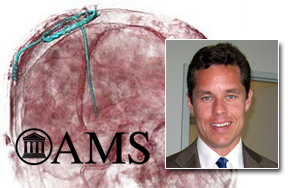Dr. Christopher Butson Interviewed for AMS
 It may not sound like much fun having an electrode implanted in your brain, yet it's much better than not being able to hold anything even for a second, which can happen to someone with Parkinson's disease or essential tremor. Deep brain stimulation is effective in treating these conditions, but determining the proper stimulating parameters can take many hours and can require multiple visits by patients. Mathematics is part of a new approach that reduces the time needed to find optimal settings of the electrodes from several hours to a few minutes. First, mathematical models describe a person's brain accurately. Then systems of differential equations that represent neuron behavior are solved numerically. This combination allows doctors to see the results of different strategies in real time and speed their patients' return to normal lives.
It may not sound like much fun having an electrode implanted in your brain, yet it's much better than not being able to hold anything even for a second, which can happen to someone with Parkinson's disease or essential tremor. Deep brain stimulation is effective in treating these conditions, but determining the proper stimulating parameters can take many hours and can require multiple visits by patients. Mathematics is part of a new approach that reduces the time needed to find optimal settings of the electrodes from several hours to a few minutes. First, mathematical models describe a person's brain accurately. Then systems of differential equations that represent neuron behavior are solved numerically. This combination allows doctors to see the results of different strategies in real time and speed their patients' return to normal lives. The significant breakthroughs in this field are in the integration of different types of data into useful models, the efficient visualization of three-dimensional images, and the delivery of this kind of information via a simple tablet interface. These breakthroughs allow physicians to download a faithful model of a patient's brain with one tap on their mobile device and interact with it so they can predict the clinical response depending on how stimulation is prescribed. The power of math and computer visualization thus makes it more convenient for clinicians, who can use their smartphones and tablets, and patients, who receive good therapeutic benefit with the fewest possible visits for deep brain stimulation programming.
For More Information:"Evaluation of Interactive Visualization on Mobile Computing Platforms for Selection of Deep Brain Stimulation Parameters," Christopher R. Butson, et al., IEEE Transactions on Visualization and Computer Graphics, Vol 19 (2013), issue 1.
Listen to the interview
| Part 1 | Part 2 |
